“We’re all here because we’re not all there!”
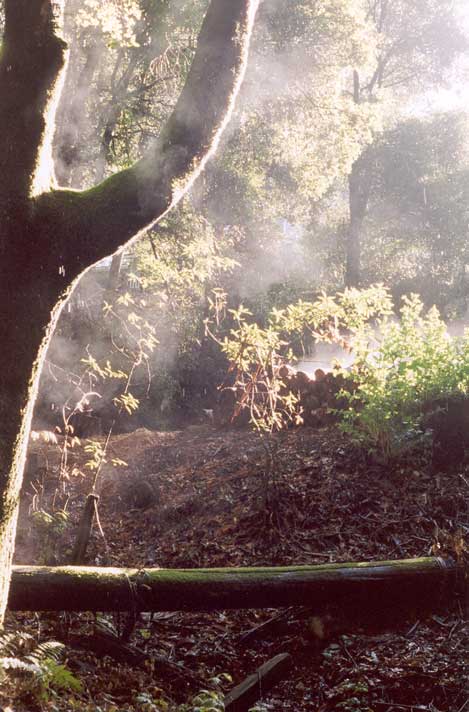
Taken on our property after a storm that lasted a few days in October 2004. The sun came up in the morning, and the mist poured out of the trees: stunning. Not a lot of rain here, but when it comes it makes for some beauatiful scenery.
I rather like that one. But the humorous side of it really does not apply to Santa Cruz. Not that we don’t have our fair share of New Age and other bizarre creeds and practices: we definitely do, in spades!
But there’s a pretty high level of something here too: maybe intelligence, maybe empathy, maybe spirituality, maybe freedom (there’s town just down the coast called Freedom, California: an inspiring post office to mail letters from!), some valuable human quality, I don’t know exactly which, but I know it’s high.
Ha ha ha ha ha!

A whole clump of Bay on our neighbors’ land that was eroded by the creek and fell in a storm in early 2008. The seasonal creek is in full flow on the left. (Click to expand!)
Of the 16 years that our family spent all together, 13 were spent in Santa Cruz, 1997 to 2010. Our children came of age here: they don’t know it yet, and maybe one or two of them never will, but we gave them a childhood in a little piece of paradise.
We were extraordinarily lucky to be able to live here all that time. This is the future, “Small is Beautiful,” and it is bright. We surmounted hurdle after hurdle here, until we came to one too high even for us. But if you have to come a cropper somewhere, let it be in a place like this!
Santa Cruz sits in California where the redwoods meet the wine country meets the mountains meet the coast.

Paula’s surf cafe, where we love the $1.99 “Basic Breakfast”, where surfboards, surfing magazines and surfing posters serves as decoration, and where even the hard-working manager is a surfer!
Roll the combination around your mind for a moment. The redwoods: the giant Sequoias have gone from the local countryside, easy logging in the second half of the last century to build San Francisco and other nearby cities, but they live on not so far away, the oldest living things on the planet, an awesome natural world to explore and feel close.
We have 40 normal-sized redwoods on our property, dating from the logging, and they’re like oaks in England, solid, dependable, a reassuring part of the California landscape. Their roots mesh with each other, supporting each other in a storm. Many trees have fallen over the years on our property: quite a few Bay, the odd Douglas fir, that’s the natural order of things in a forest. Never a redwood. It is impossible to tire of walking around our almost three acres and feeling their canopy overhead: the adjective used to describe a canopy of redwoods is normally “majestic;” even our modest copses give you a piece of that.
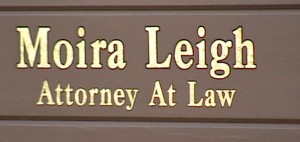
You need to keep your wits about you in Santa Cruz: Fergus, who regales in solving crossword puzzles, caught this one on Walnut Street. Think about it: is the law a moral profession?
The wine country, vineyard after vineyard right next door, is dotted across the Santa Cruz Mountains: several local friends each own their little vineyard, and proudly share one of their own bottles with us every once in a while. The whole town, even its back country hamlets, is fascinated by wine. I’m no oenolog, but enjoy spending time with those who are. There’s money in wine, of course, but hearing complaints from a local vintner about treading grapes all weekend demonstrates that, at least on a small scale, this is a business where profits are inextricably linked to a very real kind of hard work.
Santa Cruz is here because the San Lorenzo River flows into the ocean here, giving the early missionaries and other white settlers a few miles of relatively flat land between the ocean and the mountains. But it’s the mountains, the Santa Cruz Mountains, that have shaped this little town.
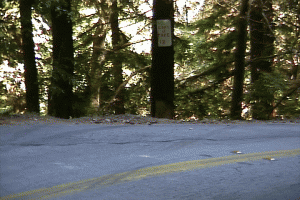
Many roads in the county are as bad as highway 17. This is Granite Creek Road. Check out the sign (click!), the assorted skidmarks and the bark worn off the base of the trunk. By what, you may well ask! The cars lose.
To this day, there is no easy road here from San Francisco Bay, the local urban conurbation. We have highway 17, a four-lane highway running from Santa Cruz to San Jose, “over the hill,” as the locals say. Patchen Pass caps the 13-mile stretch of 17 through the mountains. It’s only 1,800 foot high, but that’s not what defines this highway:
“SR 17’s combination of narrow shoulders, dense traffic, sharp turns, blind curves, wandering fauna such as deer and mountain lions, and sudden changes in traffic speeds have led to driving conditions that result in a number of accidents and fatalities, leading to the reputation of SR 17 as one of the most dangerous highways in the state.” That’s Wikipedia, and they omitted the reverse camber on some of those curves.
All those hazards lumped together on the main road to Santa Cruz is what keeps our town small and quaint. The urban conurbation visits us on summer weekends, but has never managed to engulf us, even though we are very close to each other.
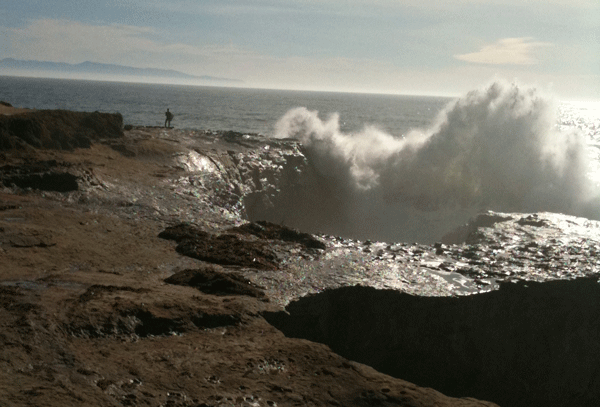
Taken on a bike ride during a winter swell off Lighthouse Field. The lighthouse is out of the frame to the left. The solitary surfer is waiting for a break in the waves that will give him time to paddle out. Just look at that breaker!
The urban conurbation visits the ocean and the beach. Ever since I was a small boy in England, the seashore has fascinated me. The shore here is as interesting as it can get. We’re at the very top of Monterey Bay, and the sandstone shoreline crumbles and changes under the weight of those Pacific Ocean breakers. Main beach is surrounded by long cliffs west and east (yep, at the top of the Bay, the shoreline runs West to East), which hide their own discrete coves between headlands and promenades.

Mavericks in February 2010, taken and copyrighted by Brocken Inaglory, found on Wikipedia under “Maverick’s – Location.” Click to see the surfer!
It is these headlands that create the surfing breaks which raised Santa Cruz’s profile in the 1950s and ’60s. Maverick’s, California’s big wave surf spot, first braved by Jeff Clark, then 17, surfing alone or in front of his high school buddies in 1975, is an hour up the coast. Perhaps because Maverick’s is close enough for Santa Cruz surfers to reach whenever the swell is good, Santa Cruz big wave surfers are among the best in the world. Think Peter Mel and Darryl (“Flea”) Virostko.
I don’t need the big waves, although the occasional swell is just fine. I just like to bike along West Cliff Drive, next to the breakers and the spray on the rocks, watch the colors of the sky and sea change every day, I mean it, every day, and see the surfers up close off Lighthouse Field, where there are waves breaking almost whenever you pass by, not all big waves, but most of the time surfable waves.
I like to see the women sunbathing and watch the young families with their children splashing happily in the waves, eagerly running toward one, more eagerly running away from it, excited cries and squeals, on Natural Bridges State Beach, where the natural bridges are now down to one but the Monarch butterflies still arrive every year, a featherweight throng settling a couple of hundred yards inland.
I like to gaze south across the Bay past the sailboats and the fishing boats to Moss Landing and Pacific Grove, or out west across the ocean to where the whales migrate every year, and to feel the fog coming and going, and the tide rising and falling, and the waves breaking and retreating, day after day after day, as I ride by. That’s enough for me.

These signs are collectors items! The signs disappear almost as soon as they are put up, with the regrettable result that none currently survive. The City of Santa Cruz remains a nuclear-free zone, by municipal ordinance.
Around 60,000 lucky souls share this natural wonder. Few of them spent formative years in Birmingham. Few of them know how lucky they are. I never forget how lucky we are.
We are 15 minutes from the ocean, and an hour away from Monterey and Carmel. Pacific Grove too is about an hour around the Bay, and Big Sur an hour and a half. On the urban level, San Jose and Cupertino are 45 minutes away, Palo Alto an hour, San Francisco an hour and a quarter, and Berkeley an hour and a half.
If you haven’t guessed already, we love it here!

An art car, splendidly decorated just to be interesting and evocative, on Cooper Street just off Pacific Avenue in downtown Santa Cruz.
Santa Cruz has what each of us in the family needs. Here’s a partial list of the highlights:

The beaches are everybody’s highlight. Here’s Alex in May 2004. We were eating a Mother’s Day brunch with the Hanlons, at Zelda’s on Capitola Beach: literally, the restaurant’s deck is on the beach.
1. We have to start with beaches. This is a holiday town, a tourist destination, and holidays and tourists are all about beaches. Over time, I’ve noticed that we residents begin to take them for granted. One of us will go to a party on the beach or a barbecue at one of the fire pits on a beach, one of us will play a game of beach soccer or volleyball on Main Beach, or a group of us will share a meal for a special occasion at one of the cafes with a terrace on the beach. Because that’s where you go, that’s what you do. We’re all here because it’s all here. We don’t even think about it.
2. Surf shops, surf culture, surfboards, and the Silicon Valley business people who get up early to surf for an hour before their morning commute (there are more of them here than you’d think), and who talk about the expected swell and the day’s surfing and how it compared to other days and other waves. They’re like fishermen, comparing catches and the one who got away! Then there’s skate shops like Bill’s Wheels, not particularly fancy places, but with a good stock of the bits and pieces that skateboarders all need, because skateboards impact after impact and break pretty often. Bill’s Wheels is where first Alban and then Alex equipped himself to enjoy the assortment of well-designed skate parks and other skating opportunities in the local towns.
3. Pacific Garden Mall downtown. Actually, it’s no longer called that: it’s simply Pacific Avenue now. The Mall was all but flattened by the Loma Prieta earthquake in October 1989, and they rebuilt it in a more open and conventional plan. But it’s still a great place for strolling on a summer evening, window-shopping and listening to the always evolving local buskers (Tom was one for a while, with his guitar and a couple of friends playing behind an open guitar case facing passers-by, a gentle invitation to make a donation). There’s coffee to be had at places like Lulu’s and Verve, as well as the national brand coffee shops, where Marie-Hélène can watch the world go by from her table on the sidewalk and feel like she’s back on a boulevard in Paris, without the cold and rain that she found there most of the year.
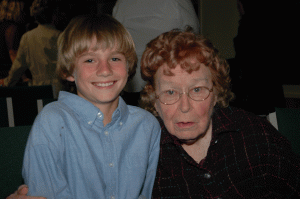
Our second last happy Happy Valley School graduate, Charlie, with Mrs. Coonerty on graduation day in 2007.
3. Bookshop Santa Cruz, one of the stores on Pacific Avenue and one of the last survivors (they operated out of a tent during the aftermath of the earthquake) of the eclectic and earnest bookstores that thrived with the hippies, founded in the late 60s and bought by the parents of the current owner in 1973. It is feeling the digitalization of content, and the threat it poses to more traditional media, but maintains a loyal customer base, a fascinating collection of books and an eclectic assortment of readings. The current owner is the granddaughter of the woman who looked after our children during their breaks at Happy Valley School, there known as Mrs. C., until her retirement in 2007 at age 93 or 94. We didn’t ask which! She watched over her charges in the playground every day until she retired.

One more beach photo, this one from nine years earlier, Daphné and Tom had the same idea in St Malo. Here they are with Roxanne, who later became Charlie and Alex’s Godmother. Tom has always been a good sport.
4. The remaining hippies. I must confess that, as a former hippy, I have a fair bit of sympathy for those who remain. As long as there have been hippies, Santa Cruz has always been a base of hippiedom. When I first used to drive here with friends in 1976 or 77, for a weekend away from studying at Berkeley, we would sleep on Main Beach, literally, without anyone caring. It was the sun that woke us up the next morning. Not sure that things still work that way. Clint Eastwood made a Dirty Harry movie a few years later with a nasty rape scene set under the wharf on Main Beach: that was just a morbid fantasy. His perpetrators were a Republican stereotype of bad people, and thus did look like hippies. No way, Clint; love your films, but no way! Hippies were a force for good: “damn hippies,” snarls Alex!
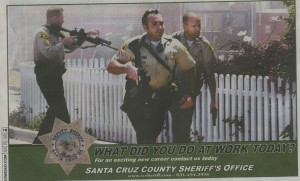
Law enforcement can be a challenge in a liberal community. Bet the County Sheriff lived to regret this ad.!
5. The LGBT contingent is very welcome here. Adrienne Rich, the feminist poet and one of the old guard of US lesbians, makes her home near the town, but she was far from the first. There was Charley Parkhurst, the cross-dressing stagecoach driver who was one of the first women registered to vote in the US, because she pretended to be a man. This was in 1867. Here is Adrienne, in the classic “From an Old House in America:”
“But can’t you see me as a human being
he said
What is a human being
she said
I try to understand
he said
what will you undertake
she said
will you punish me for history
he said
what will you undertake
she said
do you believe in collective guilt
he said
let me look in your eyes
she said . . .”.
Wow! She probably wrote that before moving here, but it still echoes all around our little town.

Here’s the man himself! Having made surfing possible in the cold water of the Pacific Ocean, Jack O’Neill now spends most of his time doing charitable work.
6. Jack O’Neill, inventor of the wetsuit for surfing, originator of the O’Neill mark that you now see throughout the world, and a true individual, US style, still makes his home here. Not surprisingly, Santa Cruz Skateboards is also based here, with its clothing line popular all over the world and ugly blue hand logo. There are other surf and skate related industries, and then there are the techie entrepreneurs, more or less famous, in the area. We’re just over the hill from Silicon Valley. Philippe Khan moved here from Paris and founded four companies over time, beginning with Borland and continuing with Starfish (anyone remember Sidekick, Outlook before email?) and LightSurf. He invented the camera phone here when his daughter was born in 1997, the year we arrived, by jury-rigging a camera with a cell phone.
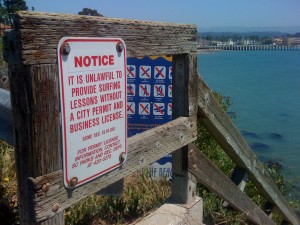
Love this sign! Somehow, the Coastal Commission permitted it to be placed on the clifftop, perhaps to enable Santa Cruz to earn a little money from surfing! The municipal wharf is in the background.
7. The Pacific Ocean is the star of our show, with its cooling breezes almost every evening, giving us a climate to envy, even if Marie-Hélène does think that she was sold a bill of goods on the temperature here, because of that natural air conditioning. It also gives us the surprisingly uncluttered promenade of West Cliff Drive, where there is only one house between the the sidewalk on the cliff and the ocean in the two or three miles of strolling between the Dream Inn (next to the Wharf) and Natural Bridges. There are no businesses on the same stretch of scenic byway, and only a couple of two-story apartment blocks: all within the city limits. Santa Cruz can’t claim all the credit for this rural landscape right on the ocean: the California Coastal Commission protects it so insistently that the city can’t even install more “No parking” signs without their consent!
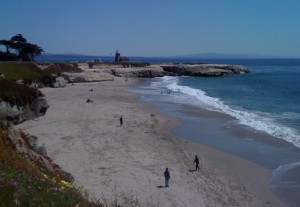
Here’s one of those beaches nestled among the headlands. Steamer Lane is the other side of the headland where the lighthouse stands: it’s a surfing museum.
8. The most beautiful University campus that you have ever seen. I know, I know, there are too many superlatives on this page, but there are so many superlatives in our town that to portray it accurately we have no choice but to use them. UCSC, the University of California at Santa Cruz, or Uncle Charlie’s Summer Camp, depending on your viewpoint, was voted in 2002 or 3 one of the best party schools in the entire US! The campus is an old ranch, the Cowell Ranch, that looks out over Monterey Bay from above the west side of town. The Colleges are built nestled among the redwoods high on a plateau, and when the trees thin out the view from the meadows spreads out forever, encompassing the town in the foreground and then the mountains and the ocean as far as the eye can see. One of those meadows hosts an annual pot-appreciation event every April 20: fortunately, none of our children has any interest in such things!

The Santa Cruz and Big Trees Railroad’s Christmas Special at the Boardwalk. Courtesy of Roaring Camp Railroad.
9. This one is mine: I’m a train freak, which is quite a difficult obsession to satisfy in the US. Roaring Camp Railroads is kind enough to run a tourist train from the Boardwalk on Main Beach through the redwoods up the San Lorenzo Valley to Roaring Camp in Felton. The locomotive is a diesel, because the city won’t allow a steam engine to pollute our air. The company’s steam engines run on the lines that climb up into the mountains from Roaring Camp. The track used is part of the railroad which originally delivered the logged redwoods from the mountains to the docks or mills in Santa Cruz at the end of the nineteenth century.
10 percent of the votes cast in Santa Cruz County in the 2002 presidential election went with no apologies to Ralph Nader. The bumper sticker that most attracted our attention, until Marie-Hélène realized the “jeu de mots,” or play on words, and banned it: Gotta Lick Bush and Dick! You’re right: not funny at all! Especially not at Alex‘s Catholic pre-school!
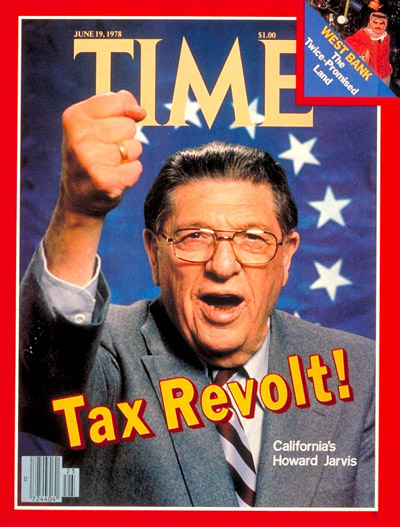
The populist at work. Howard Jarvis’s initiative gave major corporations and landowners a windfall, but of course allowed property taxes to be higher for new property owners in the future, because the cap was a percentage of the real property’s current value when acquired.
Is there a downside to our little piece of paradise? Yes, and of course it is man-made. In 1978, while I was a junior at Cal, voters passed the Jarvis-Gann initiative, an easy initiative for voters to pass because it was designed to stop property taxes increasing. Nothing like a simple argument to motivate voters! Especially when their property taxes had been going up too fast in the preceding years.
Hidden in this initiative was a provision which made it impossible for the legislature to increase property taxes in the future without a majority of 66%. Guess how many times taxes have been increased since 1975? None, or close to it. But every populist fool who comes along attracts those same shareholder votes with promises to reduce a tax or fee.
In short, the State is now in the absurd situation (considering the wealth of its natural resources and the success of its industry and entrepreneurs) of having no money, and I mean no money. Higher education has been suffering from this for years: now secondary and even elementary education is suffering. What kind of populous is not prepared to finance adequately the education of its own children? It’s an embarrassment. It’s a disgrace.
Then, less consistently, but occasionally it’s a real worry, the same nature which enriches our daily lives messes with them too. Our storms, hard-driving and powerful, give us power cuts with monotonous regularity, as the trees fall on the wires. Why can’t PG&E create a power transmission grid with a little redundancy? Every so often, a storm will wash out a major piece of road, and it will slide down the hillside in a river of mud. Trees fall regularly on our and our neighbors’ property. Here is a photo of one that landed on Edgar, our first luckless motorhome.
The whole world knows of the most significant of our real problems, , the San Andreas fault. 1989’s Loma Prieta earthquake on that fault devastated our downtown, killing several. Every time we fell the earth move, even a little jolt, and we feel them more often than I’d like, we fight the panic: is this the big one?
It’s due, it’s overdue, and it’s inevitable. I don’t even like to write that down, because avoiding this particular inevitability has a particular appeal. We’re not going to slide into the ocean, as those jealous people back East wish periodically, but something enormous will indeed happen, sooner or later.
The San Andreas fault hovers over each of us, and over all of the wonders of our little town, like a constant well-hidden premonition.






